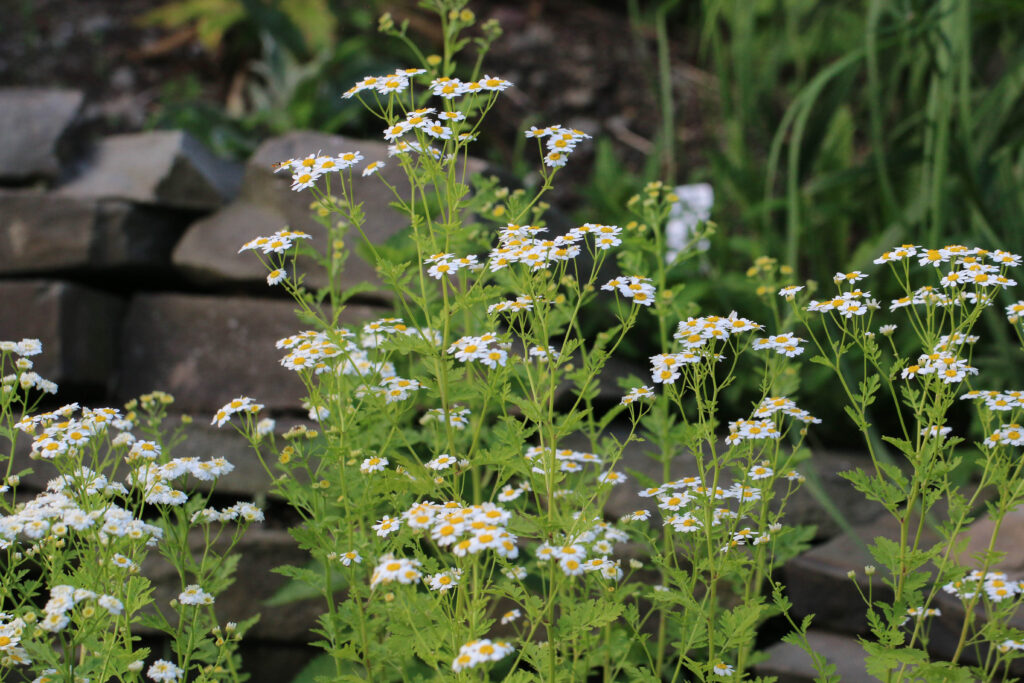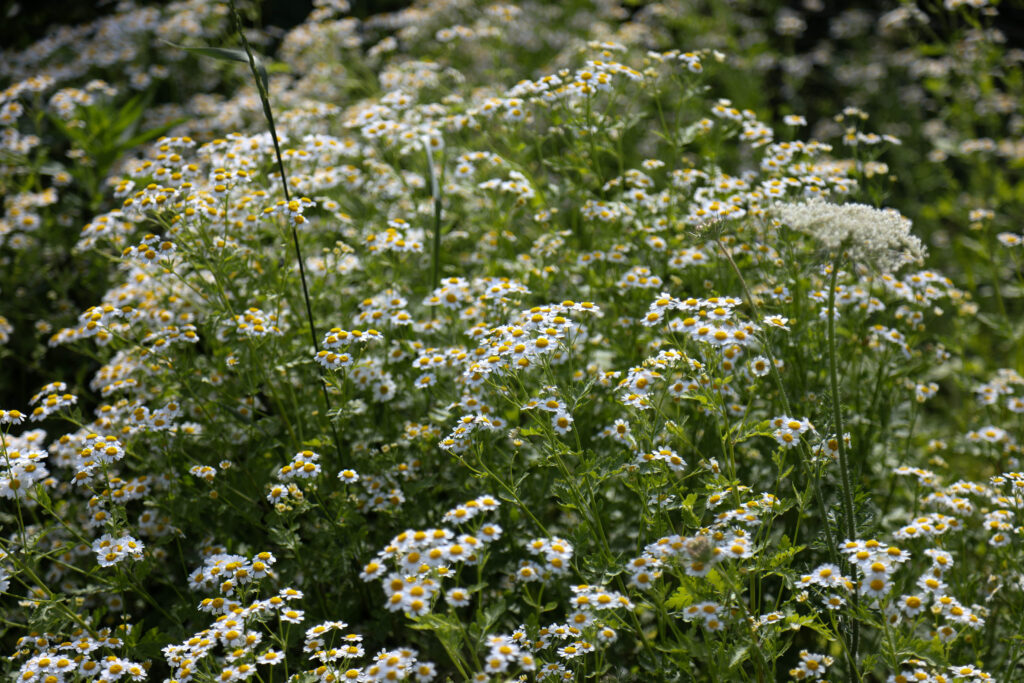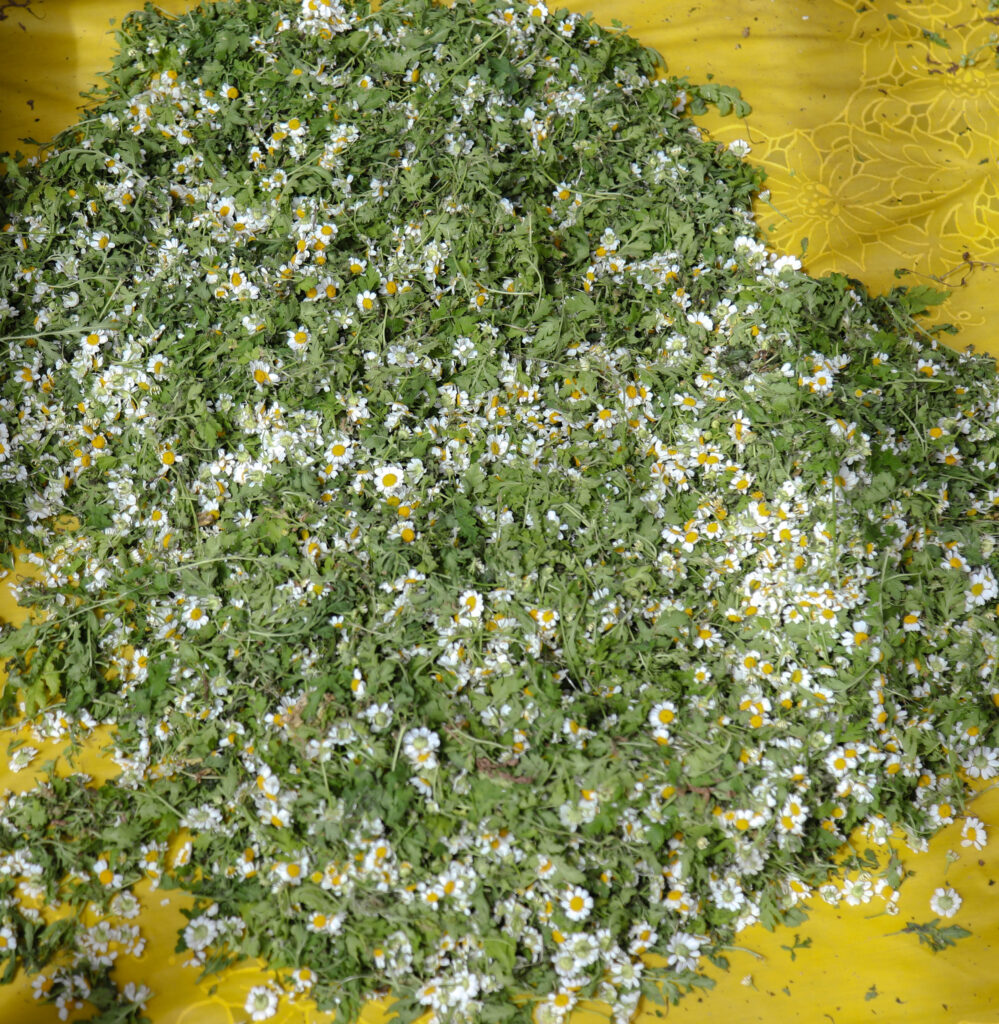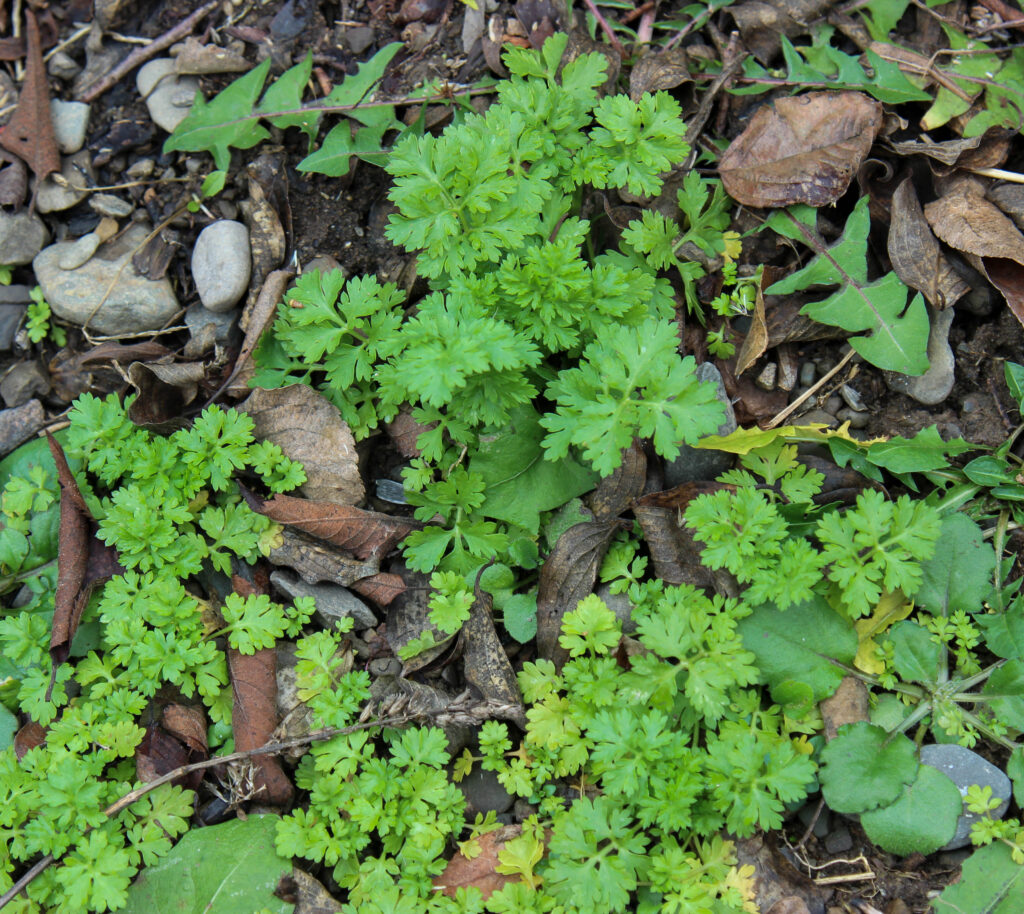
Overview
Feverfew has a long history of medicinal uses, with historical writings going back to 70 AD (Dioscorides, De materia medica). It has been continually mentioned in European medical works since. Some of its early uses are still used by herbalists, while others are not. This is typical of most medicinal plants. Applications that were once popular fall out of favor, and new uses take precedence.
Feverfew has long been used as a migraine remedy, anti-inflammatory, fever reducer, and pain reliever. All of these are still used in current herbal medicine practice.
There are many research papers on Feverfew, looking at historical uses as well as conducting trials for new applications. One that I am particularly interested in is its possible use in neuropathic (nerve) pain.
I regularly use Feverfew at the Ithaca Free Clinic. I find it helpful for chronic joint pain such as arthritis or Lyme disease as well as headaches. It also combines well with other medicinal plants.
There are safety considerations when using Feverfew, though I have not yet encountered these in clinical practice (see Safety)
Botanical Information
Feverfew’s botanical name is Tanacetum (formerly Chrysanthemum) parthenium. It is in the Asteraceae (Sunflower family).
Tanacetum originates from the Greek ‘athanasia,’ meaning ‘immortality.’
Parthenium refers to the Parthenon. One commonly encountered story states that the plant was used for medicine after someone fell off the Parthenon during its construction. This seems unlikely to me, as the plant was not named for another 2200 years. But it is a good story.
The name Feverfew is straightforward, that is, to reduce fevers (antipyretic). However, it is more commonly used as an antiinflammatory, which may secondarily reduce fevers.

Feverfew plants in my garden
Plant Information
The leaves and flowers of Feverfew are the parts used medicinally. It is easy to cultivate and will flower for a few months (at least here in the Northeastern US). There are many Feverfew cultivars grown for their showiness. They may or may not be medicinally active.
One thing to consider if growing Feverfew for medicine is that you may need a lot of plants. This is because there are not that many flowerheads or leaves per individual plant. It also takes a while to strip off all the flowers and leaves from the stems.
Commercial Feverfew varies considerably in quality. Look for plant material that still has color and has not all faded to brown.

Medicinal Preparations
Feverfew can be prepared into a variety of medicinal preparations. These include capsules, glycerite, liniment, powder, tea, and tincture. One thing to consider is that once picked, the therapeutic activity will decrease over time. The dried herb forms, such as capsules, powder, and tea, will break down more quickly than those put into a stable menstruum, such as alcohol or glycerin.
I mainly use Feverfew tincture for its convenience and potency.
Feverfew can also be used externally as a liniment or tea.

Medicinal Uses
Feverfew is antiinflammatory, anodyne (pain relieving), antipyretic (fever reducing), and headache remedy. While there are many other traditional uses, these are the main ways I use Feverfew.
Inflammation is a part of the immune response and is at the root of many health issues. Our bodies initiate an inflammatory response to pathogens and injuries. These inflammatory molecules help prevent further harm and initiate repair. But they also lead to many painful symptoms. For instance, the inflammatory response to damaged joint tissue leads to joint pain and arthritis. This inflammatory cascade can also initiate fever. Inflammation is the basis for many types of pain. A plant with antiinflammatory action can have multiple benefits for the body. The concern is that by down-regulating inflammation, you may also down-regulate and impair immune function. This is seen with steroidal pharmaceuticals such as prednisone. I have not seen Feverfew cause this effect, but it could be difficult to detect.
I find Feverfew better suited for chronic rather than acute inflammation. For acute inflammation, I find Arnica more effective.
Because Feverfew reduces pain by reducing inflammation, it does not cause sedation like other pain remedies.
It is most well-known for helping with migraine headaches. In practice, I have only seen it help about 10-15% of the time, but for those folks, it is a valuable remedy.
There have been some recent studies showing its benefit for neuropathic (nerve) pain. Since this is very common, I hope to try it after reading through more research. I have tried it a few times with fibromyalgia pain, and one time it was clearly helpful, so I will continue to use it this way as well.
As for its fever reducing (antipyretic) ability, I have not used it much this way. I can see how it would be helpful by reducing the inflammatory molecules (pyrogens) that initiate fever.
I have also used it in formulas for respiratory inflammation due to Covid. The formulas were sometimes helpful, but it is difficult to know what part Feverfew played in reducing the symptoms.
To sum up, I use Feverfew for inflammation, especially chronic inflammation due to injury or infection (such as joint pain from chronic Lyme disease). I find it useful for arthritis and other joint pains. It can be helpful for migraines, and I am starting to use it more for complex pain syndromes such as fibromyalgia and may begin using it for neuropathic pain.

Dosage
Dosages vary widely depending on the presenting symptom(s) and underlying causes. Feverfew is also dose dependent, meaning the more one takes, the stronger the effect (up to a point). These are very broad guidelines for inflammation. Start with a smaller dosage, increase it over time and watch for any adverse effects. The dosages will also vary if the Feverfew is in a formula.
- Capsule-1-2 caps 3 times daily.
- Tincture or glycerite ½-1½ dropperfuls 2-5 times daily.
For migraine headaches
Take Feverfew at the first sign of an impending migraine. For the tincture or glycerite, start with 5 drops and increase the dosage as needed. Watch for any adverse reactions, as headaches are often taste sensitive. Knowing how much to take initially can be challenging, as it is being used preventatively. Once the correct dosage is known, future dosing can be started from that amount. It can also be taken when there is a current migraine, but they are much more difficult to treat once the pain begins. These dosages can also be tried for non-migraine headaches.
Medicine Making
These are 3 ways I have prepared Feverfew. All of these are then pressed out in a minimum of 2 weeks.
- Tincture-fresh flower and leaf. 1:4 in 80%alcohol
- Tincture-dried flower and leaf. 1:5 in 50% alcohol
- Glycerite-freshly dried flower and leaf. 1:7 in vegetable glycerin. Then put into a hot water bath for 1.5 hours.

Combinations
Feverfew combines well with other medicinal plants for various health ailments. When preparing an individual’s formula, consider the underlying cause of the condition. For instance, with headaches, are they due to stress, structural difficulties, or a migraine? These are only a few possibilities for each category.
For its antiinflammatory action, consider combining it with Japanese knotweed (Reynoutria japonica), Black birch (Betula lenta), Willow (Salix species), Yucca (Yucca species), and Devil’s claw (Harpagophytum procumbens).
As a headache remedy, Chamomile (Matricaria chamomilla), Wood betony (Betonica officinalis), Lobelia (Lobelia inflata), and Blue vervain (Verbena hastata).
For pain, Jamaican dogwood (Piscidia piscupula), Skullcap (Scutellaria lateriflora), Hops (Humulus lupulus), and Valerian (Valeriana officinalis).
This is a formula for Lyme-related joint pain. The percentage of each herb in this formula will depend on the symptoms.
- Japanese knotweed (Reynoutria japonica)-antiinflammatory
- Feverfew (Tanacetum parthenium)-antiinflammatory
- Devil’s claw (Harpagophytum procumbens)-antiinflammatory
- Jamaican dogwood (Piscidia piscupula)-pain
- Japanese barberry (Berberis thunbergii)-antibacterial
- Echinacea (Echinacea purpurea)-antibacterial
Safety
It is difficult to ascertain the true safety implications of Feverfew and other medicinal plants. This is because there have not been any rigorous studies or data compilation. Plants can have adverse effects, but except for some obvious ones (i.e., allergic reactions to Chamomile), there is still a lot of speculation about how herbs might negatively affect the body or react with conventional medications.
Feverfew seems reasonably safe, and I have not seen any of the below issues. But if a person had an adverse reaction, they may not come back to see me, and I would not be aware of their negative response.
As with all medicinal plants, there is the possibility that Feverfew could interact with pharmaceutics, either negatively or positively.
There are multiple reports of people developing a skin rash from handling the fresh plant.
It should be avoided in pregnancy, as it may act as an emmenagogue bringing on menses.
As with all new medications, take proper precautions and monitor yourself for any potential adverse reactions.
